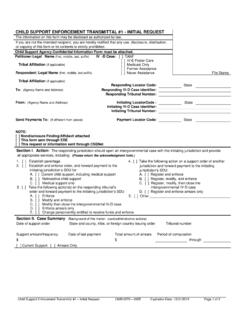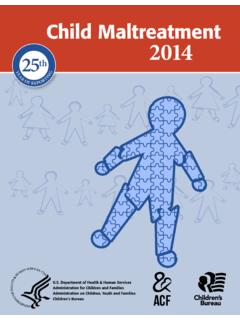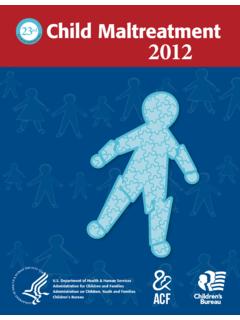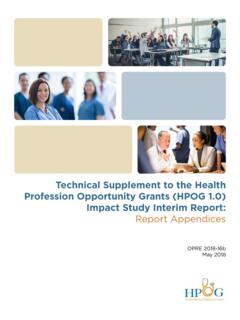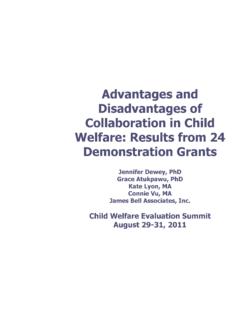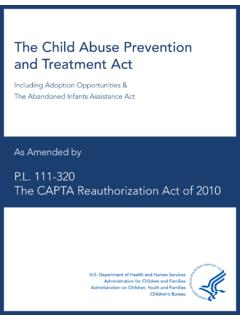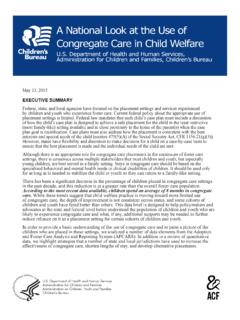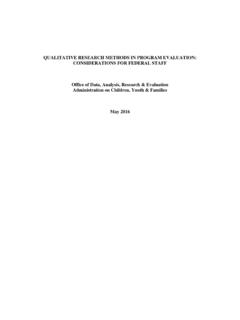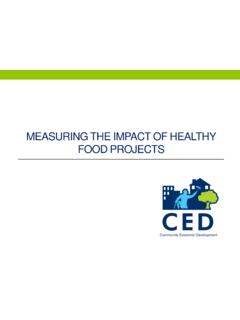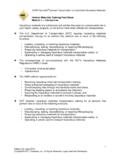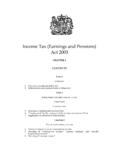Transcription of Child Maltreatment 2016 - Home | Administration for ...
1 Child Department of Health & Human ServicesAdministration for Children and FamiliesAdministration on Children, Youth and FamiliesChildren s BureauYEAROF REPORTING25thYEAROF REPORTING27thThis report was prepared by the Children s Bureau ( Administration on Children, Youth and Families, Administration for Children and Families) of the Department of Health and Human Services. Public Domain Notice Material contained in this publication is in the public domain and may be reproduced, fully or partially, without permission of the federal government. Electronic Access This report is available on the Children s Bureau website at Questions and More InformationIf you have questions or require additional information about this report, please contact the Child Welfare Information Gateway at or 1 800 394 3366.
2 If you have questions about a specific state s data or policies, contact information is provided for each state in Appendix D, State Commentary. Data SetsRestricted use files of the NCANDS data are archived at the National Data Archive on Child Abuse and Neglect (NDACAN) at Cornell University. Researchers who are interested in these data for statistical analyses may contact NDACAN by phone at 607 255 7799, by email at or on the Internet at NDACAN serves as the repository for the NCANDS data sets, but is not the author of the Child Maltreatment report. Recommended Citation Department of Health & Human Services, Administration for Children and Families, Administration on Children, Youth and Families, Children s Bureau.
3 (2018). Child Maltreatment 2016. Available from Federal ContactsDori Sneddon, MSW Office on Child Abuse and Neglect Children s Bureau/ACYF/ACF/HHS Mary E. Switzer Building, #3417C 330 C Street SW Washington, DC Howard, PhD, MSW, LCSW Office on Child Abuse and Neglect Children s Bureau/ACYF/ACF/HHS Mary E. Switzer Building330 C Street SW Washington, DC MaltreatmentLetter from the Associate Commissioner: Child Maltreatment 2016 is the 27th edition of the annual Child Maltreatment report series. States provide the data for this report through the National Child Abuse and Neglect Data System (NCANDS). NCANDS was established in 1988 as a voluntary national data collection and analysis program to make available state Child abuse and neglect information.
4 Data have been collected every year since 1991, and NCANDS now annually collects Maltreatment data from Child protective services agencies in the 50 states, the District of Columbia, and the Commonwealth of Puerto Rico. Key findings in this report include: The national estimate of children who received a Child protective services investigationresponse or alternative response increased percent from 2012 (3,172,000) to 2016(3,472,000).1 The number and rate of victims have fluctuated during the past 5 years. Comparing thenational rounded number of victims from 2012 (656,000) to the national estimate of victimsin 2016 (676,000) shows an increase of percent.
5 Three-quarters ( ) of victims were neglected, percent were physically abused, percent were sexually abused. For 2016, a nationally estimated 1,750 children died of abuse and neglect at a rate of 100,000 children in the national Child Maltreatment report series is an important resource relied upon by thousands of researchers, practitioners, and advocates throughout the world. The report is available from our website at NCANDS would not be possible without the time, effort, and dedication of Child welfare and information technology staff working together on behalf of children and families. We gratefully acknowledge the efforts of all involved to make resources like this report possible, and will continue to do everything we can to promote the safety and well-being of our nation s children.
6 Sincerely,/s/ Jerry Milner Associate Commissioner Children s Bureau Administration FOR CHILDREN AND FAMILIES Administration on Children, Youth and Families 330 C Street, SW, Washington, 20201 DEPARTMENT OF HEALTH & HUMAN SERVICES1 If fewer than 52 states reported a count, the national rate is used to compute a national estimate. If all 52 states report, the count is rounded. From 2012 through 2015, 52 states reported data; for 2016, 51 states reported. Letter iiChild Maltreatment 2016 AcknowledgementsThe Administration on Children, Youth and Families (ACYF) strives to ensure the well-being of our Nation s children through many programs and activities.
7 One such activity is the National Child Abuse and Neglect Data System (NCANDS) of the Children s Bureau. National and state statistics about Child Maltreatment are derived from the data collected by Child protective services agencies and reported to NCANDS. The data are analyzed, dissemi-nated, and released in an annual report. Child Maltreatment 2016 marks the 27th edition of this report. The Administration hopes that the report continues to serve as a valuable resource for policymakers, Child welfare practitioners, researchers, and other concerned citizens. The 2016 national statistics were based upon receiving case-level and aggregate data from the 50 states and the District of Columbia.
8 ACYF wishes to thank the many people who made this publication possible. The Children s Bureau has been fortunate to collaborate with informed and committed state personnel who work hard to provide comprehensive data, which reflect the work of their agencies. ACYF gratefully acknowledges the priorities that were set by state and local agencies to submit these data to the Children s Bureau, and thanks the caseworkers and supervisors who contribute to and use their state s information system. The time and effort dedicated by these and other individuals are the foundation of this successful federal-state Maltreatment 2016 Acknowledgements iiiContentsLetter from the AssociAte commissioner iiAcknowLedgements iiisummAry viiichApter 1: introduction 1 Background of NCANDS 1 Future Reporting to NCANDS 2 Annual Data Collection Process 2 NCANDS as a Resource 3 Structure of the Report 4 chApter 2: Reports6 Screening 6 Investigations and Alternative Responses 7 Report Sources 8 CPS Response Time 9 CPS Workforce and Caseload 9 Exhibit and Table Notes 9chApter 3.
9 Children15 Alternative Response 16 Unique and Duplicate Counts 17 Children Who Received an Investigation or Alternative Response 17 Children Who Received an Investigation or Alternative Response by Disposition 18 Number of Child Victims 18 Child Victim Demographics 19 Maltreatment Types 20 Risk Factors 21 Special Focus on Victims With Alcohol and Drug Abuse Risk Factors 22 Perpetrator Relationship 23 Exhibit and Table Notes 24 chApter 4: Fatalities53 Number of Child Fatalities 53 Child Fatality Demographics 54 Maltreatment Types 56 Risk Factors 56 Perpetrator Relationship 56 Prior CPS Contact 57 Exhibit and Table Notes 57 Child Maltreatment 2016 Contents ivChapter 5: Perpetrators 65 Number of Perpetrators 65 Perpetrator Demographics 65 Perpetrator Relationship 66 Exhibit and Table Notes 67 Chapter 6: Services 77 Prevention Services 77 Postresponse Services 79 History of Receiving Services 80 Part C of the Individuals With Disabilities Education Act (IDEA) 80 Exhibit and Table Notes 81appendix a: Required CAPTA Data Items 94appendix B.
10 Glossary 96appendix C: State Characteristics 112appendix d: State Commentary 120 Child Maltreatment 2016 Contents vExhibitsExhibit S 1 Summary of Child Maltreatment Rates per 1,000 Children 2012 2016 xiExhibit S 2 Statistics at a Glance, 2016 xiiExhibit 2 A Referral Rates, 2012 2016 7 Exhibit 2 B Report Disposition Rates, 2012 2016 7 Exhibit 2 C Report Sources, 2016 8 Exhibit 3 A Child Disposition Rates, 2012 2016 17 Exhibit 3 B Children Who Received an Investigation or Alternative Response by Disposition, 2016 18 Exhibit 3 C Child Victimization Rates, 2012 2016 19 Exhibit 3 D Victims by Age, 2016 19 Exhibit 4 A Child Fatality Rates per 100,000 Children.
